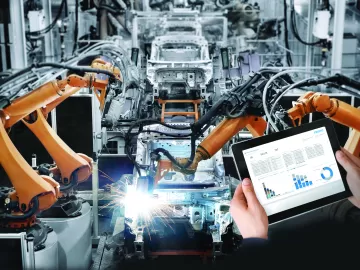Improving Sustainability Through Compressed Air and Utilities Monitoring
Utilities monitoring paired with machine learning models can reliably predict anomalies, prompting action that can prevent waste and optimize resource use.

If there was ever a place where manufacturers can save energy using compressed air and make measurable gains toward sustainability, it’s with pneumatics that power a seemingly infinite variety of machines and processes.
Utilities monitoring paired with machine learning models can reliably predict anomalies, prompting action that can prevent waste and optimize resource use.
The history of Festo began in 1925 in Germany. Festo USA was founded on March 15th, 1972 in Port Washington on Long Island, with the focus of being a full-line supplier of pneumatics – a focus we continue with today.
Sustainability is a high priority for today’s consumer packaged goods (CPG) companies. Driven by environmental responsibility, government regulations and customer preferences, CPGs are actively seeking ways to decarbonize their packaging lines and use eco-friendly packaging materials. Many have started monitoring the energy consumption of their equipment in real time and upgraded critical areas of their packaging processes using two key technologies: pneumatics and ultrasonic welding.
The industrial internet of things (IIoT) and industry 4.0 have digitally transformed the way facilities operate, enabling processes that are smarter and more efficient than ever before. But digital transformation is still new to some and may seem abstract or ambiguous. In actuality, it’s quite the opposite.
Industrial operations and manufacturers using pneumatics have access to more Industrial Internet of Things (IIoT) technology than ever before, from position sensors on cylinders to system flow sensors and edge gateways that operate independently from the machine controller with globally accepted communication protocols.
In manufacturing and packaging facilities that rely on pneumatics, there’s a four-letter word worse than virtually any other: leak. Unidentified air leakage and unexpected maintenance in pneumatic systems are significant sources of revenue and productivity loss but identifying the cause of leakages and preventing unforeseen downtime is typically a challenge.
Electricity and compressed air play an important role in the thermal and kinetic processes for everything from mixing and extruding the ingredients, deep-freezing to -13°F (-25°C), dipping into various chocolate coatings through to final packaging. Energy efficiency is therefore right at the top of Unilever’s list of priorities. As part of the Unilever Sustainable Living Plan, this global corporation has succeeded in saving more than \$186 million in energy costs from efficiency improvements in production alone since 2008.
In this article, we discuss problems associated with static electricity in industrial manufacturing operations and how to effectively address them. At the atomic level, materials have a balance of positively charged protons in the nucleus and negatively charged electrons in the shell. Balance requires the same number of each. A static charge occurs when that balance shifts due to the loss or gain of one or more electrons from the atom or molecule. The primary mechanism for this loss or gain, among several possibilities, is friction.
Reverse pulse type dust collectors often represent a challenge to compressed air energy efficiency, and sometimes throw a wrench into the works by causing huge air pressure fluctuations, high transient flows and just plain large leaks. This article discusses this type of dust collector, often installed in food processing plants, and gives some real-life examples of problematic installations. Some suggested measures are mentioned to ensure your dust collectors keep running in a trouble-free manner.
The advent of manifold-mounted, plug-in pneumatic valves has been a boon for machine builders. It allows them to mount complete valve packages in a safe and secure location on a machine. Using a D-sub connector, serial interface module, or similar single-point wiring system, all of the electrical control outputs can feed into one location on the manifold, greatly simplifying the wiring.